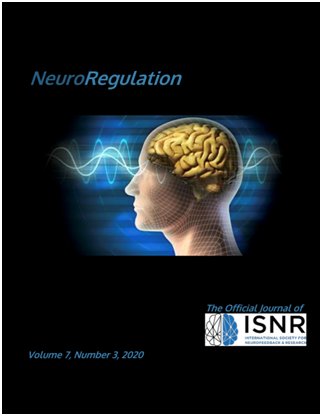Using Neurofeedback to Lower PTSD Symptoms
DOI:
https://doi.org/10.15540/nr.7.3.99Keywords:
PTSD, Neurofeedback, Trauma, Affect regulationAbstract
This study examines the effectiveness of neurofeedback training for individuals presenting with a primary concern of posttraumatic stress disorder symptoms. The present study includes 21 adult clients with 62% (n = 13) self-reporting as female. Participants completed pre- and postassessments including the Davidson Trauma Scale and Inventory of Altered Self-Capacities and participated in neurofeedback training sessions twice a week for one academic semester. Neurofeedback training involved decreasing 2–6 Hz and 22–36 Hz while increasing 10–13 Hz with a placement of T4 as the active site and P4 as the reference site. Study findings demonstrated statistically significant improvement in affect regulation and trauma symptom severity and frequency. We present limitations and implications for future research.
References
Beeson, E. T., & Field, T. A. (2017). Conducting brain-based research and program evaluation. In T. A. Field, L. K. Jones, & L. A. Russell-Chapin (Eds.), Neurocounseling: Brain-based clinical approaches (pp. 213–226). Alexandria, VA: American Counseling Association. https://doi.org/10.1002/9781119375487.ch13
Briere, J. (2000). Inventory of Altered Self-Capacities professional manual. Odessa, FL: Psychological Assessment Resources.
Briere, J., & Runtz, M. (2002). The Inventory of Altered Self-Capacities (IASC): A standardized measure of identity, affect regulation, and relationship disturbance. Assessment, 9(3), 230–239. https://doi.org/10.1177/1073191102009003002
Cohen, J. (1988). Statistical power analysis for the behavioral sciences (Rev. ed.). New York, NY: Academic Press.
Davidson, J. (1996). Davidson trauma scale professional manual. North Tonawanda, NY: Multi-Health Systems Inc.
Douthit, K. Z., & Russotti, J. (2017). Biology of marginality: A neurophysiological exploration of social and cultural foundations for psychological health. In T. A. Field, L. K. Jones, & L. A. Russell-Chapin (Eds.), Neurocounseling: Brain-based clinical approaches (pp. 45–60). Alexandria, VA: American Counseling Association. https://doi.org/10.1002/9781119375487.ch3
Gapen, M., van der Kolk, B. A., Hamlin, E., Hirshberg, L., Suvak, M., & Spinazzola, J. (2016). A pilot study of neurofeedback for chronic PTSD. Applied Psychophysiology and Biofeedback, 41(3), 251–261. https://doi.org/10.1007/s10484-015-9326-5
Jones, M. S. (2015). Comparing DC offset and impedance readings in the assessment of electrode connection quality. NeuroRegulation, 2(1), 29–36. https://doi.org/10.15540/nr.2.1.29
Jones, L. K., Rybak, C., & Russell-Chapin, L. A. (2017). Neurophysiology of traumatic stress. In T. A. Field, L. K. Jones, & L. A. Russell-Chapin (Eds.), Neurocounseling: Brain-based clinical approaches (pp. 61–80). Alexandria, VA: American Counseling Association. https://doi.org/10.1002/9781119375487.ch4
Marzbani, H., Marateb, H. R., & Mansourian, M. (2016). Neurofeedback: A comprehensive review on system design, methodology and clinical applications. Basic and Clinical Neuroscience, 7(2), 143–158. https://doi.org/10.15412/J.BCN.03070208
McLean, C. P., & Foa, E. B. (2013). Dissemination and implementation of prolonged exposure therapy for posttraumatic stress disorder. Journal of Anxiety Disorders, 27(8), 788–792. https://doi.org/10.1016/j.janxdis.2013.03.004
National Library of Medicine. (2002). EMDR. The Harvard Mental Health Letter, 18(8), 4–5. Retrieved from http://search.proquest.com/docview/71492232/
Othmer, S., & Othmer, S. F. (2009). Post traumatic stress disorder—The neurofeedback remedy. Biofeedback, 37(1), 24–31. Retrieved from http://search.proquest.com/docview/208152800/
Peniston, E. G., & Kulkosky, P. J. (1991). Alpha-theta brainwave neuro-feedback for Vietnam veterans with combat-related post-traumatic stress disorder. Medical Psychotherapy, 4, 47–60.
Schumm, J. A., Dickstein, B. D., Walter, K. H., Owens, G. P., & Chard, K. M. (2015). Changes in posttraumatic cognitions predict changes in posttraumatic stress disorder symptoms during cognitive processing therapy. Journal of Consulting and Clinical Psychology, 83(6), 1161–1166. https://doi.org/10.1037/ccp0000040
Sherry, D. F. (2006). Neuroecology. Annual Review of Psychology, 57, 167–197. https://doi.org/10.1146/annurev.psych.56.091103.070324
Sitaram, R., Ros, T., Stoeckel, L., Haller, S., Scharnowski, F., Lewis-Peacock, J., … Sulzer, J. (2016). Closed-loop brain training: The science of neurofeedback. Nature Reviews Neuroscience, 18(2), 86–100. https://doi.org/10.1038/nrn.2016.164
van der Kolk, B. A., Hodgdon, H., Gapen, M., Musicaro, R., Suvak, M. K., Hamlin, E., & Spinazzola, J. (2016). A randomized controlled study of neurofeedback for chronic PTSD. PLoS ONE, 11(12), e0166752. https://doi.org/10.1371/journal.pone.0166752
van Dijk, L., & Myin, E. (2019). Ecological neuroscience: From reduction to proliferation of our resources. Ecological Psychology: Gibsonian Neuroscience, 31(3), 254–268. https://doi.org/10.1080/10407413.2019.1615221
Downloads
Published
Issue
Section
License
Authors who publish with this journal agree to the following terms:- Authors retain copyright and grant the journal right of first publication with the work simultaneously licensed under a Creative Commons Attribution License (CC-BY) that allows others to share the work with an acknowledgement of the work's authorship and initial publication in this journal.
- Authors are able to enter into separate, additional contractual arrangements for the non-exclusive distribution of the journal's published version of the work (e.g., post it to an institutional repository or publish it in a book), with an acknowledgement of its initial publication in this journal.
- Authors are permitted and encouraged to post their work online (e.g., in institutional repositories or on their website) prior to and during the submission process, as it can lead to productive exchanges, as well as earlier and greater citation of published work (See The Effect of Open Access).











